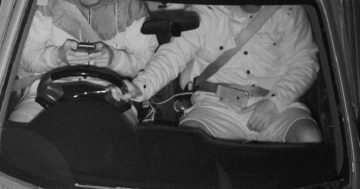
The storage of mobile speed camera signs is causing difficulties in NSW. Photo: Transport for NSW.
Almost three-quarters of NSW’s mobile speed camera fleet is grounded by – of all things – a lack of cargo space.
From 1 January, the State Government was required to refit all of their 143 mobile speed camera vehicles with two clear warning signs, after a dramatic spike in speeding fines prompted intense public backlash.
These were to be displayed on the side of the road before and after the mobile speed camera.
However, it didn’t take long for the contractors – hired by the NSW Police Force – to discover the sandwich-style “Your speed has been checked” signs were unable to safely fit in 105 of the vehicles.
As a result, this leaves 38 mobile speed camera vehicles in operation across the entire state. The solution will either involve a retrofit or replacement, but either way, it’s not likely until April 2023.
The roadside warning signs were removed in November 2019 in an attempt to crack down on speeding – “the biggest killer on NSW roads”. The threshold for low-level speeding fines also dropped.
The result was $45 million in speeding fines over 12 months – more than twice that of the previous financial year – despite a tragic 21 more road fatalities between September 2021 and 2022.
Opposition leader Chris Minns dubbed the scheme “revenue-raising on a giant scale”. And it didn’t take long for motorists to respond either, with some going so far as to make their own warning signs and place them in front of mobile speed camera vehicles.
In April 2022, Transport for NSW agreed to refit warning signs to the top of mobile camera vehicles, followed by new guidelines a few months later to prevent the cameras from ‘hiding’ behind trees, poles, or parked cars.
“We have had a number of instances where mobile speed cameras have parked behind trees or poles, making it difficult for drivers to be alert to a mobile speed camera operating in the area,” NSW Minister for Regional Transport and Roads Sam Farraway said at the time.

The signs can’t safely fit inside the Nissan X-Trail models. Photo: Transport for NSW.
The mobile speed camera warning policy in NSW has now shifted right back to where it started.
The current fleet in NSW is made up of Nissan X-Trail, MG HS, Toyota Kluger and Hyundai Santa Fe vehicles.
The larger Kluger and Santa Fe vehicles have been in use since before the removal of the warning signs, but during a budget estimates hearing, Transport for NSW deputy secretary Tara McCarthy revealed at least 47 previous-generation T32 X-Trails lack the cargo space to carry the camera and safety equipment as well as the warning signs.
Ms McCarthy said these cars would either require “significant modification” or may need to be replaced altogether.
“Transport for NSW is working closely with its mobile speed camera vendors to install safe and secure signage racking solutions in all mobile speed camera vehicles,” she told Region.
“The vehicle fit out will be completed by April 2023.”
What’s left of the NSW mobile speed camera fleet is now the most clearly signposted program in Australia, with more advisory signage than ever before.
Over the border in the ACT, the 10-strong fleet of mobile speed cameras are managed by Access Canberra and take the form of white Volkswagen Multivan vehicles with a “Your speed has been checked” rooftop sign.
Earlier last year, they dropped the lollipop sign displaying the posted speed limit, ostensibly for safety reasons.
“The signs cannot be automated and therefore required an operator to leave the van to install them, presenting a number of safety risks to operators,” Access Canberra said.
“It’s the responsibility of all road users to know the speed of the road they’re on at any time.”





















